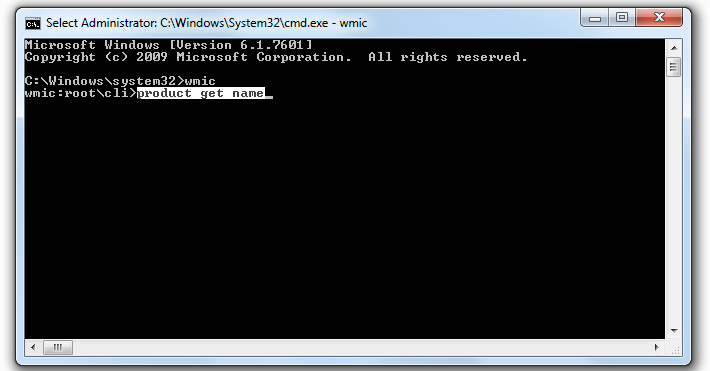Uninstall Programs From Command Line Vista
Sometimes we will have to uninstall a program or software in automated way which does not require any user interaction. We can use wmic product command in such scenarios. Below you can find the syntax and also few examples. Below is the command we need to use to uninstall a program. Wmic product where 'description='program name' ' uninstall Note that you need to provide accurate program name along with the version if it’s part of the program name. Wmic product get lists all the installed programs in the command prompt. You can use findstr command in combination with wmic command.
Is it in any way possible to uninstall PowerShell from Windows Vista?. There is no Uninstall option under Start/All Programs. It's start menu group is actually located under Accessories which is hard to find at first. There is no uninstaller. It doesn't show up in the Add/Remove program list (Programs and Features).
Then, not a longer time I wanted it to uninstall from my. How to uninstall a program through command. When I searched whether any wrong programs over. This will generate a list of installed applications. At the prompt, execute the following command: product where name=' call uninstall. Where application name is the name of the program you wish to uninstall (use the exact name provided by the previously generated list).
Installshield Uninstall Command Line
It's actually hidden in the Installed Updates window. It's not listed as 'PowerShell' in the Installed Updates window. It's actually named 'Management Framework Core'. Why I need to remove it The reason I need to remove it is because the Windows Vista setup program requires that I remove PowerShell before I can do a repair install of Windows.
Windows 7 Uninstall Programs From Command Line
(Click on image for larger view.) What I have done so far Uninstalling KB968930 a.k.a. Management Framework Core a.k.a. PowerShell I obviously tried uninstalling it from the Programs and Features window in Control Panel. But it's actually only accessible as an update from Installed Update window.
Control Panel. Programs (or 'Uninstall a program').
Programs and Features. Click on 'View installed updates' link on the left.
Type in 'KB968930' in the Search field. Select 'Windows Management Framework Core (KB968930)' from search results. Click Uninstall button. 'Are you sure you want to uninstall this update?' . 'Please wait while the updates are being uninstalled. This might take several minutes.'
. 'An error has occurred.
Not all of the updates were successfully uninstalled.' This did not resolve the issue. Registry change, taking ownership and renaming of folder Next, I tried changing the following registry key. FROM THIS: Key: HKEYLOCALMACHINE SOFTWARE Microsoft PowerShell 1 Value: Install Type: RegDword Data: 0 TO THIS: Key: HKEYLOCALMACHINE SOFTWARE Microsoft PowerShell 1 Value: Install Type: RegDword Data: 1 Then I started elevated cmd prompt and I used it to take ownership of the PowerShell directory. C: Windows system32takeown /f%windir% system32 windowspowershell SUCCESS: The file (or folder): 'C: Windows system32 windowspowershell' now owned by user 'computername username'. C: Windows system32cacls%windir% system32 windowspowershell /G administrators: F No mapping between account names and security IDs was done.
C: Windows system32icacls%windir% system32 windowspowershell /G administrators:F Invalid parameter '/G' C: Windows system32cacls%windir% system32 windowspowershell /G administrators: F No mapping between account names and security IDs was done. C: Windows system32icacls%windir% system32 windowspowershell /grant administra tors:F administrators: No mapping between account names and security IDs was done. Successfully processed 0 files; Failed processing 1 files C: Windows system32 I wasn't sure whether I should use the cacls or icacls command and I wasn't sure of the syntax (any input on that?). I was now the owner of the directory and I was able to rename it. Win+R. C: Windows System32. Renamed 'WindowsPowerShell' to 'WindowsPowerShellOld' So the path is now C: Windows System32 WindowsPowerShellOld.
PowerShell is now 'somewhat' disabled i.e. Shortcuts on Start menu don't work now and running powershell.exe directly from C: Windows System32 WindowsPowerShellOld v1.0 shows a cmd like command prompt with black background and several red error lines that say 'file not found'. But the main problem is still not solved. I still can't do repair install of Windows. Setup program still reports that PowerShell is installed. Any clever ideas? What else can I do?
The only thing that remains now is to do a clean install of Windows. Don't forget to rename the PowerShell folder in the 64-bit folder! I think that did the trick. Win+R. C: Windows System32. Enter.
Rename 'WindowsPowerShell' to 'WindowsPowerShellOld'. Win+R. C: Windows SysWOW64. Enter. Rename 'WindowsPowerShell' to 'WindowsPowerShellOld'. If you get any UAC prompts just click to confirm or provide a password if needed, and click on Continue if you get any warning about performing these operations.


You should definitely try uninstalling KB968930 first (as noted above) and see if that works. If you encounter any errors uninstalling this like I did or if the Windows setup program still says you need to uninstall PowerShell to continue even after you have removed KB968930 then try renaming these folders. I would suggest that you skip the registry trick at first, and that you skip taking ownership of these folders.
Just go straight to the folders in Windows Explorer and try renaming them as noted above. If you are unable to rename them, go ahead and make the registry change (as noted above) and also take ownership of these folders. Alternatively, you can rename the folders as 'WindowsPowerShell2'. I don't know if this has any effect on it. It really should not. This is actually the bogus name I used last time. But I think the really important thing is to rename the folder inside C: Windows SysWOW64.